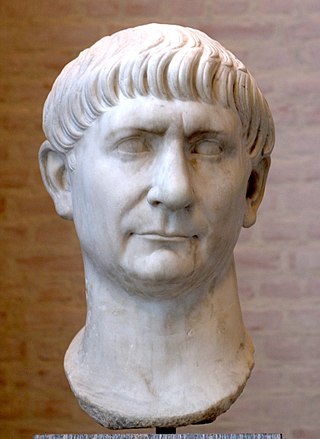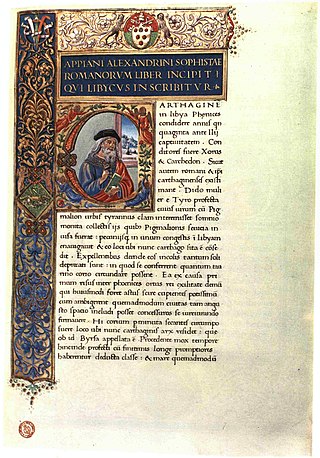Related Research Articles

Hadrian was Roman emperor from 117 to 138. Hadrian was born in Italica, close to modern Seville in Spain, an Italic settlement in Hispania Baetica; his branch of the Aelia gens, the Aeli Hadriani, came from the town of Hadria in eastern Italy. He was a member of the Nerva-Antonine dynasty.

Marcus Aurelius Antoninus was Roman emperor from 161 to 180 AD and a Stoic philosopher. He was a member of the Nerva–Antonine dynasty, the last of the rulers later known as the Five Good Emperors and the last emperor of the Pax Romana, an age of relative peace, calm, and stability for the Roman Empire lasting from 27 BC to 180 AD. He served as Roman consul in 140, 145, and 161.

Trajan was Roman emperor from 98 to 117 AD, the second of the Five Good Emperors of the Nerva–Antonine dynasty. He was a philanthropic ruler and a successful soldier-emperor who led the Roman Empire to its greatest territorial extent by the time of his death. He was given the title of optimus by the Roman Senate.

Lucius Aurelius Verus was Roman emperor from 161 until his death in 169, alongside his adoptive brother Marcus Aurelius. He was a member of the Nerva-Antonine dynasty. Verus' succession together with Marcus Aurelius marked the first time that the Roman Empire was ruled by more than one emperor simultaneously, an increasingly common occurrence in the later history of the Empire.

The sestertius, or sesterce, was an ancient Roman coin. During the Roman Republic it was a small, silver coin issued only on rare occasions. During the Roman Empire it was a large brass coin.
The donativum was a gift of money by the Roman emperors to the soldiers of the Roman legions or to the Praetorian Guard. The English translation is donative.

Appian of Alexandria was a Greek historian with Roman citizenship who prospered during the reigns of Emperors of Rome Trajan, Hadrian, and Antoninus Pius.

Vologases III was king of the Parthian Empire from 110 to 147. He was the son and successor of Pacorus II.

Osroes I was a Parthian contender, who ruled the western portion of the Parthian Empire from 109 to 129, with a one-year interruption. For most of his reign he contended with the rival king Vologases III who was based in the eastern provinces. In 116, Osroes I was briefly ousted from his throne at Ctesiphon during an invasion by Roman emperor Trajan, who installed Osroes' son, Parthamaspates. After Trajan's death the following year, Osroes I's rule was reinstated by the Parthian nobility. In 129, he was removed from power by Vologases III.
The a rationibus was the secretary of finance in the Roman Empire and in charge of the imperial treasury, the fiscus. His responsibilities involved monitoring the state's revenues and expenditures and maintaining the accounts of the fiscus, giving the a rationibus considerable influence.

The Kitos War was one of the major Jewish–Roman wars (66–136). The rebellions erupted in 115 when most of the Roman armies were fighting Trajan's Parthian War on the eastern border of the Roman Empire. Major uprisings by Jews in Cyrenaica, Cyprus and Egypt spiralled out of control, resulting in a widespread slaughter of the remaining Roman garrisons and Roman citizens by Jewish rebels.

In ancient Roman religion, Annona is the divine personification of the grain supply to the city of Rome. She is closely connected to the goddess Ceres, with whom she is often depicted in art.
In Ancient Roman measurement, congius was a liquid measure that was about 3.48 litres. It was equal to the larger chous of the Ancient Greeks. The congius contained six sextarii.

Nerva was Roman emperor from 96 to 98. Nerva became emperor when aged almost 66, after a lifetime of imperial service under Nero and the succeeding rulers of the Flavian dynasty. Under Nero, he was a member of the imperial entourage and played a vital part in exposing the Pisonian conspiracy of 65. Later, as a loyalist to the Flavians, he attained consulships in 71 and 90 during the reigns of Vespasian and Domitian, respectively. On 18 September 96, Domitian was assassinated in a palace conspiracy involving members of the Praetorian Guard and several of his freedmen. On the same day, Nerva was declared emperor by the Roman Senate. As the new ruler of the Roman Empire, he vowed to restore liberties which had been curtailed during the autocratic government of Domitian.
Ulpia was a noble Roman woman from the gens Ulpia settled in Spain during the 1st century CE. She was the paternal aunt of the Roman emperor Trajan and the paternal grandmother of the emperor Hadrian.
The Roman–Parthian War of 161–166 was fought between the Roman and Parthian Empires over Armenia and Upper Mesopotamia. It concluded in 166 after the Romans made successful campaigns into Lower Mesopotamia and Media and sacked Ctesiphon, the Parthian capital.

The reign of Marcus Aurelius began with his accession on 7 March 161 following the death of his adoptive father, Antoninus Pius, and ended with his own death on 17 March 180. Marcus first ruled jointly with his adoptive brother, Lucius Verus. They shared the throne until Lucius' death in 169. Marcus was succeeded by his son Commodus, who had been made co-emperor in 177.

Gaius Caristanius Fronto was a Roman soldier and equites whom Vespasian promoted to the Roman Senate for his loyalty to the latter in the Year of Four Emperors. He was appointed suffect consul in AD 90 as the colleague of Quintus Accaeus Rufus.

In Imperial Rome, Cura Annonae was the import and distribution of grain to the residents of the cities of Rome and, after its foundation, Constantinople. The term was used in honour of the goddess Annona. The city of Rome imported all the grain consumed by its population, estimated to number 1,000,000 by the 2nd century AD. This included recipients of the grain dole or corn dole, a government program which gave out subsidized grain, then free grain, and later bread, to about 200,000 of Rome's adult male citizens. Rome's grain subsidies were originally ad hoc emergency measures taken to import cheap grain from trading partners and allies at times of scarcity, to help feed growing numbers of indebted and dispossessed citizen-farmers. By the end of the Republic, grain subsidies and doles had become permanent, uniquely Roman institutions. The grain dole was reluctantly adopted by Augustus and later emperors as a free monthly issue to those who qualified to receive it. In 22 AD, Augustus' successor Tiberius publicly acknowledged the Cura Annonae as a personal and imperial duty, which if neglected would cause "the utter ruin of the state".
The gens Velia was a minor plebeian family at ancient Rome. Members of this gens are first mentioned in the latter part of the first century AD. The first of the Velii to obtain the consulship was Decimus Velius Fidus in AD 144.
References
- 1 2 3
 This article incorporates text from a publication now in the public domain : Smith, William, ed. (1870). Dictionary of Greek and Roman Antiquities . London: John Murray.
This article incorporates text from a publication now in the public domain : Smith, William, ed. (1870). Dictionary of Greek and Roman Antiquities . London: John Murray.{{cite encyclopedia}}: Missing or empty|title=(help) - ↑
 This article incorporates text from a publication now in the public domain : Chambers, Ephraim, ed. (1728). Cyclopædia, or an Universal Dictionary of Arts and Sciences (1st ed.). James and John Knapton, et al.
This article incorporates text from a publication now in the public domain : Chambers, Ephraim, ed. (1728). Cyclopædia, or an Universal Dictionary of Arts and Sciences (1st ed.). James and John Knapton, et al.{{cite encyclopedia}}: Missing or empty|title=(help) - ↑ Bury, John Bagnell. The Student's Roman Empire . Harper. 1893. p 436.
- ↑ Ferdinand Gregorovius. The Emperor Hadrian . Macmillan. 1898. ISBN 0-7905-5228-0. p 214.